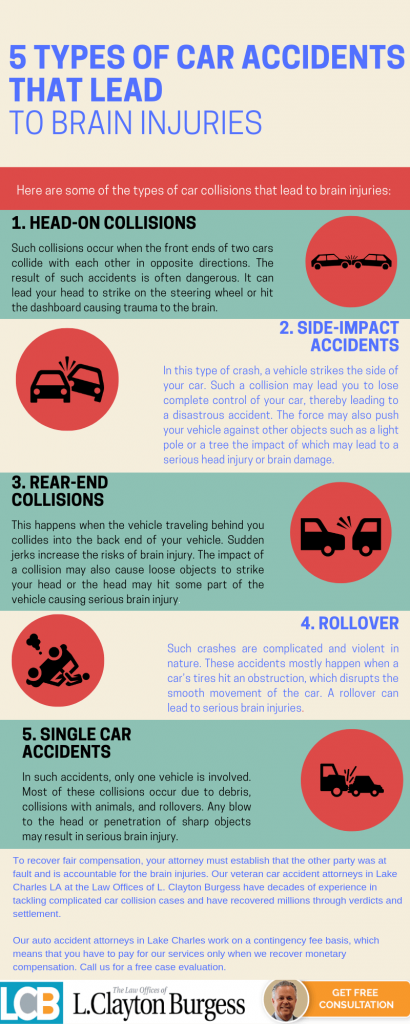Motor vehicle accidents are unfortunate events that can have severe consequences, especially when it comes to the well-being of the individuals involved. Among the myriad of potential injuries, brain injuries stand out due to their long-lasting impact on a person’s life. In this article, we’ll delve into the various types of car accidents that commonly result in brain injuries and explore ways to mitigate these risks.

Introduction
Car accidents are unpredictable, but understanding the types that often lead to brain injuries is crucial for drivers and passengers alike. The trauma resulting from such incidents can vary, but brain injuries are a common and serious consequence. Let’s explore the five types of car accidents that frequently lead to these life-altering injuries.
1. Rear-End Collisions
Rear-end collisions may seem minor, but the abrupt force from the impact can cause the head to snap back and forth rapidly, leading to whiplash and potential brain injuries. Even at lower speeds, the vulnerability of the head and neck makes this type of accident a significant risk for trauma to the brain.
2. Side-Impact Collisions
Also known as T-bone collisions, side-impact accidents can be devastating. The sides of vehicles offer less protection, and the force of impact can directly affect the occupants’ heads, increasing the likelihood of brain injuries. The lack of crumple zones on the sides adds to the severity of such accidents.
3. Roll-Over Accidents
Roll-over accidents involve a vehicle overturning onto its side or roof. The violent nature of these accidents can lead to occupants sustaining head injuries, including traumatic brain injuries (TBIs). The multiple impacts during a roll-over create an environment where the brain can be subjected to significant trauma.
4. T-Bone Collisions
T-bone collisions, where one vehicle strikes another perpendicularly, pose a high risk of brain injuries. The impact can be direct on the side where the headrest provides limited protection. The forces involved can cause the brain to move inside the skull, resulting in injuries that range from concussions to more severe trauma.
5. Single Vehicle Crashes
While multi-vehicle accidents often take the spotlight, single-vehicle crashes can also lead to brain injuries. Factors like high speed, collision with a fixed object, or rollovers can result in significant trauma. Understanding the unique risks in single-vehicle accidents is crucial for preventive measures.
Prevention and Safety Measures
To reduce the risk of brain injuries in car accidents, adopting preventive measures is essential. Wearing seat belts, ensuring proper use of airbags, and employing suitable child restraint systems are fundamental practices. Defensive driving, maintaining a safe following distance, and adhering to traffic rules contribute significantly to overall safety.
Recognizing Symptoms of Brain Injuries
It’s crucial to recognize the signs of brain injuries promptly. Symptoms may include headaches, dizziness, confusion, nausea, and changes in mood or behavior. Seeking immediate medical attention if any of these symptoms arise is paramount for early diagnosis and appropriate treatment.
Legal Implications
Understanding the legal aspects of brain injuries resulting from car accidents is vital. Consulting with a personal injury attorney can help victims navigate the complex legal landscape, ensuring they receive the compensation they deserve for medical expenses, rehabilitation, and other related damages.
Impact on Daily Life
Brain injuries can have a profound impact on a person’s daily life. From cognitive challenges to emotional changes, individuals may face various hurdles. Establishing a strong support system and exploring rehabilitation options are essential for coping with the long-term effects.
Rehabilitation and Recovery
The rehabilitation process after a brain injury is a critical phase in the journey towards recovery. Physical therapy, cognitive rehabilitation, and emotional support play key roles in helping individuals regain functionality and adjust to life post-injury.
Case Studies
Examining real-life case studies provides insights into the diverse consequences of car accidents leading to brain injuries. Each case is unique, highlighting the importance of preventive measures, immediate medical attention, and comprehensive rehabilitation.
Insurance Considerations
Navigating the insurance process following a car accident is often challenging. Understanding the role of insurance in covering medical expenses, rehabilitation, and other damages is essential for victims seeking fair compensation.
Public Awareness and Education
Increased public awareness about the risks of brain injuries in car accidents is vital for fostering a safer driving culture. Educational initiatives, campaigns, and community outreach can contribute to reducing the number of accidents and their associated injuries.